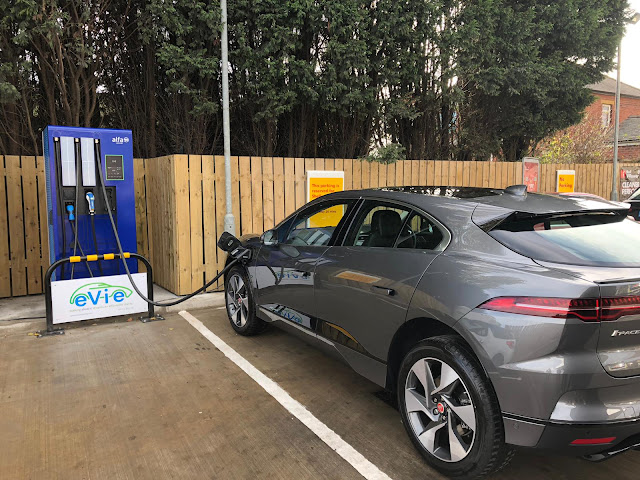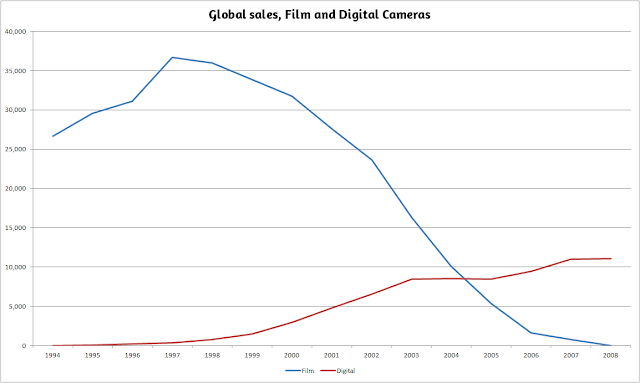The very short answer?
2040
The short answer
It takes about 8 doublings of EV sales to go from “What are EVs?” to “Remember those gasoline cars?”
We’re about three doublings in. Each doubling has taken about two years so far, and it shows no signs of slowing down.
Slow down is unlikely to set in before the process is mostly complete, for 3 reasons:
- new technology starts as a choice, but soon becomes the only option available
- the changeover doesn’t start slow and gradually grow. It starts tiny, grows exponentially fast, until things are happening in the blink of an eye. And then it’s over and done.
- the support infrastructure for the old tech withers away once you hit the middle of the change.
By the time the change is noticeable, it’s almost complete.
The long answer (part 1)
Switchovers in general
Generally, things change on an S-shaped curve, (technically a “logistics curve”).
They start really slowly and grow exponentially quickly from that teeny-tiny base. Once about a quarter of the market has swapped, things are really starting to happen fast. And they keep happening fast until the change is virtually complete, and only a very few stragglers and hold-outs remain.

The swap from film cameras to digital cameras happened in less than 10 years.
In 1995, it was a lot of effort to buy a digital camera. They were expensive. They were fragile. They had terrible picture quality - the camera filled in information to get the pictures to end up at 640 x 480 pixels.
Less than 10 years later, it was very difficult to buy a film snapshot camera. Three years after that, film cameras were rare and expensive.
The graphs show I was pretty typical. I bought my last film camera in 1997. In 2003, I bought my first "proper" digital camera. This digital camera was not simply a tech toy, but was now my regular snapshots camera.
With the film camera, I would walk to the nearest photo shop, pay to get my films developed, 24 or 36 pictures at a time; I would pay extra to get them to digitise my photographs and supply them on a CD, along with the prints, and I would pay for my next batch of blank films.
The digital camera was about twice as expensive to buy as a film camera, but the operating costs were much lower. I bought some memory sticks, and once I had them, I could re-use them over and over, so I never had to pay for blank film after that. I never had to pay for processing the film. I didn't have to pay to have the pictures digitised. And I only needed to pay to print the good pictures. No more prints of someone's thumb over the lens, or of people with their eyes tightly shut.
So, higher initial purchase cost, but much lower operating costs. High end film cameras still produced much better pictures, but for snapshots, the quality was perfectly adequate.
And soon it becomes hard to find anywhere to develop your rolls of undeveloped snapshot film. It becomes hard to find anyone making or selling snapshot cameras, or film for them. Not impossible.
Comparing the sales curves, something odd happens. Film cameras keep growing for the first few years of digicams. Once the sales of digital cameras start to be noticeable, in about 1997 or 1998, the sales of film cameras start to tumble. And fast.
And yet, digital cameras never really reach the same heights that film cameras reached in 1997.
And here's why.
The answer is of course is that technology changes so fast, that digital cameras ever really got a foothold before they were replaced. By cameras built into mobile phones and smartphones.
And now, it’s getting harder to buy a standalone snapshot camera, because smartphone cameras have just about completely taken over.
You can look at similar changeovers that have happened recently - dumb mobile phones to smartphones, cathode-ray TVs and monitors and flat-screen TVs and monitors, CDs to MP3s to streaming services.
First almost no-one has the new thing - the new thing is more expensive, and not actually as good. Then they get to be only a little more expensive, and not too much worse. And then lots of people make the swap. And the new things gets cheaper, and gets to be on a par. And the support for the old thing starts to disappear, until it becomes a speciality item, if you can get it at all.








